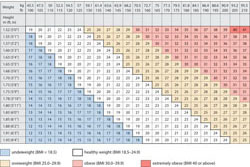2.7.1 Body Mass Index (BMI)
As mentioned above, being overweight is a risk factor for developing Type 2 diabetes. However, simply weighing someone may not accurately determine if they are overweight.
Explain how it is possible for one person who weighs 80 kg to be obese, and another person who also weighs 80 kg to be a healthy weight.
The key point is their difference in height. One may be taller and assessed as an average weight for their height, whereas the other is assessed as obese because they are much shorter.
The relationship between weight and height is determined by calculating the person’s Body Mass Index (BMI). Your BMI is defined by your weight in kilograms divided by your height in metres and the result is divided again by your height in metres.
BMI is an indicator of how healthy a person’s weight is. Figure 2.6 is a chart that will help you to calculate a person’s BMI and to use this to determine whether they are a healthy weight, underweight, overweight, obese, or extremely obese.
Directions: Find your weight in kilograms (or pounds) along the top of the table and your height in metres (or ft and inches) along the left-hand side. Your BMI is the value at the point in the table where they intersect. NB The chart does not apply to athletes, children, pregnant or lactating women.

Mr Aseged is 1.70 m tall and weighs 68 kg. Mr Abera is also 1.70 m tall but weighs 93 kg. Use Figure 2.7 to estimate their BMI. What does the BMI of each man indicate about the risk of developing Type 2 diabetes?
Mr Aseged’s BMI is 23, so he is a healthy weight for his height, which does not increase his risk of developing Type 2 diabetes. However, Mr Abera’s BMI is 32, which means he is obese and therefore at increased risk of becoming diabetic.
2.7 Risk factors for diabetes
